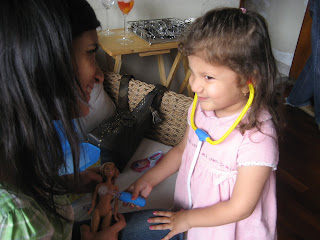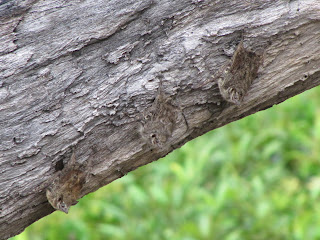
"H1N1" in the Cow Parade in LarcoMar, Miraflores.
Last night was my first Christmas Eve away from Minnesota (or for that matter my parent's house). I was kindly "adopted" by the Arambulo family and was invited to many casas (houses) as the "daughter they never had" (they have three boys, the oldest is a good friend of mine and my running buddy, Beto).
The festivities started around 9 PM. I arrived early to help Beto's mom, Charo, wrap toys for all the sobrinos y primos (nieces/nephews and cousins). Beto is celebrating Christmas in the US with his girlfriend so it was only his parents, Alberto (Lucho) and Chado, his younger brother, Jorge and his best friend Andrea who are both deaf, and I. I found it was easier to talk to them in English since they only read lips and my Spanish was too difficult for them to understand (ouch!)
We stopped by the house of their middle son, Javier, where he lives with his girlfriend, her parents and their adorable three year old son, Nicolas. The house was totally decorated with lights and had a fake Christmas tree with bows and tinsel and a room full of gifts for Nicolas. We drank Pisco sour, took photos, and chatted with their family before heading out to Lucho's mother's for dinner and presents. They served a delicious turkey baked in an Oriental sauce (mmmm muy rico!) with more wine and Vino de Higo (fig wine that is very rich Peruvian dessert wine).
In Peru, Christmas is celebrated like New Year's where everyone waits until midnight with a glass of champagne to say cheers, light off fireworks in the street and play with sparklers, eat dinner, and then open presents. After midnight as the sounds of fireworks blasted outside, we stood around the Nacimiento, the nativity scene (clay figures about 5 inches tall that was constructed to look like a mountain and occupied an entire corner of the living room. They had a manger with Mary and Joseph, shepards, 20+ sheep, cows, roosters, goats, cougar, etc. like it would have been on Christmas Eve nearly 2000 years ago. I noticed that Jesus was missing when I was admiring the scene earlier in the night and I quickly found out why. After the toast, the grandmother pulled out baby (6 inch) Jesus and made a wish, kissed his forehead and passed it around. We all made a wish, kissed baby Jesus and then she put him in the manger. The three wise men were on the table on the other side of the room and I found out that they will be making their way to the scene and will arrive on January 6, the Epiphany.
We opened presents and then went to our final stop - Charo's sister's house in Surco where the four sisters and their families were waiting to exchange presents and drink more wine. The kids had fallen asleep and some of the adults were dozing off as well. Everyone has someone in the family that they exchange with and it's a surprise so they describe who the gift is for and you have to guess. Needless to say the festivities lasted until 3 AM.
This morning we slept in until 10 and then Lucho and I went for a 6-mile run ("So we could drink more wine today" he said). We ate a light breakfast and got ready for another feast. This was more Thanksgiving dinner esque with a HUGE elaborately decorated turkey (that we didn't even cut but that sat in the table for looks), a huge cut of pig, more turkey, 12+ side dishes, 20+ bottles of wine and a punch bowl with some sort of Sangria-like mixture but with Pisco and white wine - mmm dangerous!).

Elisa, a doctor-to-be, playing with her new toys.
The kids opened presents, the 20-something-year-old "kids" hung out outside, and the "adults" sat around the dining room table talking.
 This was very similar to my family gatherings but with a lot more people and (no offense family) much more flavorful and elaborately prepared food (probably because they had two maids helping cook all the food). I will admit I miss the Snickers salad but the lucuma torta was delicious! I was properly stuffed by 8pm and took a cab back home and watched a movie in my apartment.
This was very similar to my family gatherings but with a lot more people and (no offense family) much more flavorful and elaborately prepared food (probably because they had two maids helping cook all the food). I will admit I miss the Snickers salad but the lucuma torta was delicious! I was properly stuffed by 8pm and took a cab back home and watched a movie in my apartment. 
My favorite memory of last night was when my family sang "Feliz Navidad" to my Peruvian family over skype. It was great! My little cousin David was enthusiastically leading the chorus and hand signals but immediately after the song was over he ran back to the TV to play Wii. It was great to see the foot of snow on the pine trees and all the lights at my house but, I'll be honest, I kinda like wearing short sleeve shirts and capris and not long underwear this time of year! This will be one of my most memorable Christmas's and I feel so lucky to have been invited into the Arambulo family (thank you Beto - we missed you!)

"Muuuun Walker" in the Cow Parade in Miraflores.
Tomorrow I'm going to pack for my vacation to Rio de Janeiro, Brasil. I can't wait!












































